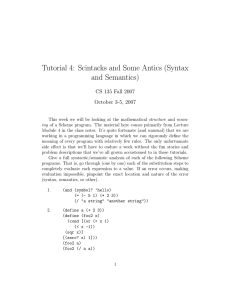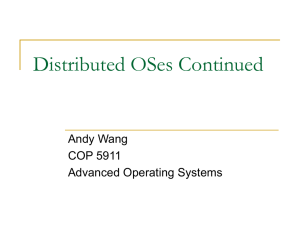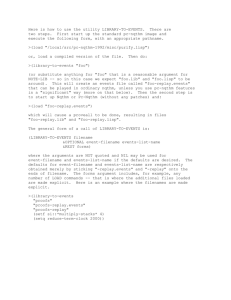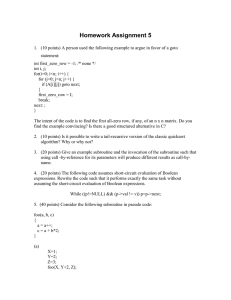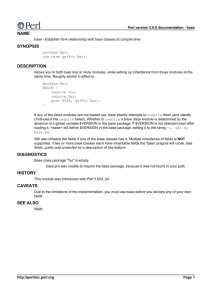Distributed OSes Continued Andy Wang COP 5611 Advanced Operating Systems
advertisement
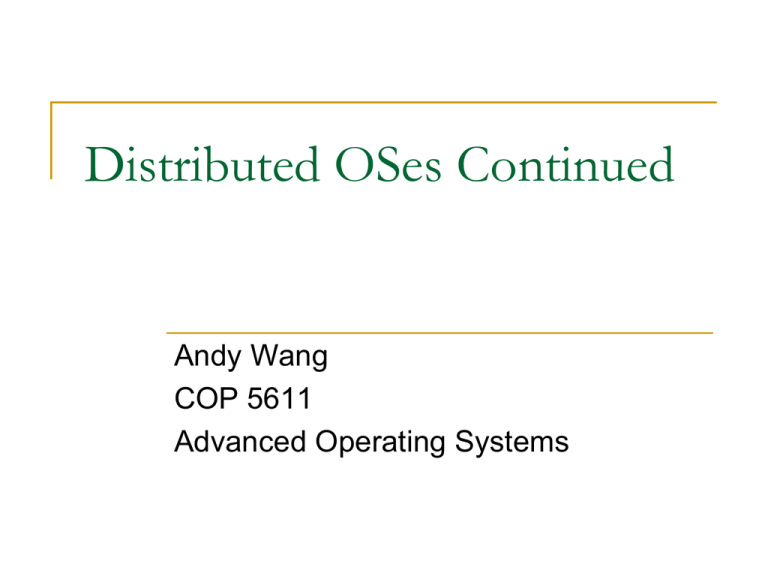
Distributed OSes Continued Andy Wang COP 5611 Advanced Operating Systems More Introductory Materials Important Issues in distributed OSes Important distributed OS tools and mechanisms More Important Issues Autonomy Consistency and transactions Autonomy To some degree, users need to control their own resources The more a system encourages interdependence, the less autonomy How to best trade off sharing and interdependence versus autonomy? Too Much Interdependence Vulnerability to failures Global control Hard to pinpoint responsibility Hard security problems Too Much Autonomy Redundancy of functions Heterogeneity Especially in software Poor resource sharing Methods to Improve Autonomy Without causing problems with sharing Replicate vital services on each machine Don’t export services that are unnecessary Provide strong security guarantee Consistency Maintaining consistency is a major problem in distributed systems If more than one system accesses data, can be hard to ensure consistency But if cooperating processes see inconsistent data, disasters are possible A Sample Consistency Problem Site A Data Item 1 Site B Site C A Sample Consistency Problem Site A Data Item 1 Site B Site C A Sample Consistency Problem Site A Data Item 1 Site B Site C A Sample Consistency Problem Site A Data Item 1 Site B Site C A Sample Consistency Problem Site A Data Item 1 Site B Site C A Sample Consistency Problem Site A Data Item 1 Site B Site C Causes of Consistency Problems Failures and partitions Caching effects Replication of data So why do this stuff? Note these problems arise because of what are otherwise desirable features Working in the face of failures Caching Avoiding repetition of expensive operations Replication Higher availability Handling Consistency Problems Don’t share data Generally not feasible Callbacks Invalidations Ignore the problem Sometimes OK, but not always Callback Methods Check that your data view is consistent whenever there might be a problem In most general case, on every access More practically, every so often Extremely expensive if remote check required High overheads if there’s usually no problem Invalidation Methods When situations change, inform those who know about the old situation Requires extensive bookkeeping Practical when changes infrequent High overheads if there’s usually no problem Consistency and Atomicity Atomic actions are “all or nothing” Either the entire set of actions occur Or none of them do At all times, including while being performed Apparently indivisible and instantaneous Relatively easy to provide in single-machine systems Atomic Actions in Single Processors Lock all associated resources (e.g., via semaphores) Perform all actions without examining unlocked resources Unlock all resources Real trick is to provide atomicity even if process is switched in the middle Why are distributed atomic actions hard? Lack of centralized control What if multiple processes on multiple machines want to perform an atomic action? How do you properly lock everything? How do you properly unlock everything? Failure conditions especially hard Important Distributed OS Tools and Mechanisms Caching and replication Transactions and two-phase commit Hierarchical name space Optimistic methods Caching and Replication Remotely accessing data in the pits It almost always takes longer It’s less predictable It clogs the network It annoys other nodes Other nodes annoy your It’s less secure Caching vs. Replication Caching vs. Replication Temporary Read-only Improve performance The notion of an original source Data Not aware of other caches Permanent Writable Improve availability Equal peers Data + metadata Aware of other replicas But what else can you do? Data must be shared And by off-machine processes If the data isn’t local, and you need it, you must get it So, make sure data you need is local The problem is that everyone else also wants their data local Making Data Local Store what you need locally Make copies Migrate necessary data in Cache data Replicate data Store It Locally Each site stores the data it needs locally But what if two sites need to store the same data? Or if you don’t have enough room for all your data? Local Storage Example Site B Site A Bar Foo Site C Froz Make Copies Each site stores its own copy of the data it needs Works well for rarely updated data Like copies of system utility programs Works poorly for frequently written data Doesn’t solve the problem of lack of local space Copying Example Site B Site A Copy of Foo Foo Site C Copy of Foo Migrate the Data In When you need a piece of data, find it and bring it to your site Taking it away from the old site Works poorly for highly shared data Can cause severe storage problems Can overburden the network Essentially how shared software licenses work Migration Example Site B Site A Foo I need Foo Site C Migration Example Site B Site A Foo Site C Caching When data is accessed remotely, temporarily store a copy of it locally Perhaps using callback or invalidation for consistency Or perhaps not Avoids problems of storage Still not quite right for frequently written data Caching Example Site B Site A Cached Foo Foo Site C Cached Foo Replication Maintain multiple local replicas of the data Changes made to one replica are automatically propagated to other replicas Logically connects copies of data into a single entity Doesn’t answer question of limited space Replication Example Site B Site A Foo2 Foo1 Site C Foo3 Replication Advantages Most accesses to data are purely local Fault tolerance So performance is good Failure of a single node doesn’t lose data Partitioned sites can access data Load balancing Replicas can share the work Replication and Updates When a data item is replicated, updates to that item must be propagated to all replicas Updates come to one replica Something must assure they get to the others Replication Update Example Site B Site A Foo2 Foo1 Site C update Foo Foo3 Replication Update Example Site B Site A Foo2 Foo1 Site C update Foo Foo3 Update Propagation Methods Instant versus delayed Synchronous versus asynchronous Propagation time Completion time Atomic versus non-atomic Effects of propagation being available Instant vs. Delayed Propagation “Instant” can’t mean instant in a distributed system Instant notification not always possible But it can mean “quickly” One update maps to one propagation What if a site storing a replica is down? So some delayed version of update is also required Potentially many updates map to one propagation Instant Update Propagation Example Site B Site A Foo2 Foo1 Site C update Foo Foo3 Instant Update Propagation Example Site B Site A Foo2 Foo1 Site C update Foo Foo3 Instant Update Propagation Example Site B Site A Foo2 Foo1 Site C update Foo Foo3 Synchronous vs. Asynchronous Propagation Update request sooner or later gets a success signal Does it get it before all propagation completes (asynchronous) or not (synchronous)? Synchronous propagation delays completion Asynchronous propagation allows inconsistencies Synchronous Propagation Example Site B Site A Foo2 Foo1 Site C update Foo Foo3 Synchronous Propagation Example Site B Site A Foo2 Foo1 Site C update Foo Foo3 Synchronous Propagation Example Site B Site A Foo2 Foo1 Site C update Foo Foo3 Synchronous Propagation Example Site B Site A Foo2 Foo1 Site C update Foo Foo3 update complete Asynchronous Propagation Example Site B Site A Foo2 Foo1 Site C update Foo Foo3 Asynchronous Propagation Example Site B Site A Foo2 Foo1 Site C update Foo Foo3 update complete Asynchronous Propagation Example Site B Site A Foo2 Foo1 Site C update Foo Foo3 update complete Atomic vs. Non-Atomic Update Propagation Atomic propagation lets no one see new data until all replicas store it Non-atomic lets users see data at some replicas before all replicas have updated it Atomic update propagation can seriously delay data availability Non-atomic propagation allows users to see potentially inconsistent data Synchronous =? Atomic Synchronous =? Atomic Synchronous write of 100MB Write will not return until 100MB are written Someone can still see half-way written file Atomic write of 100MB Someone cannot see half-way written file Can be asynchronous Replication Consistency Problems Unless update propagation is atomic, consistency problems can arise One user sees a different data version than another user at the same time But even atomic propagation isn’t enough to prevent this situation Concurrent Update What if two users simultaneously ask to update different replicas of the data? “Simultaneously” has a looser definition in distributed systems How do you prevent both from updating it? Update propagation style offers no help Concurrent Update Example Site B Site A Foo2 Foo1 Site C update Foo update Foo Foo3 Concurrent Update Example Site B Site A Foo2 Foo1 Site C update Foo update Foo Foo3 Preventing Concurrent Updates One solution is to lock all copies before making updates That’s expensive And what if one of 20 replicas is unavailable? You must allow updates to data when partitions or failures occur Locking Example Site B Site A Foo2 Foo1 Site C update Foo Foo3 Locking Example Site B Site A request lock Foo2 Foo1 request lock Site C update Foo Foo3 Locking Example Site B Site A request lock Foo2 Foo1 lock granted request lock Site C lock granted update Foo Foo3 Locking Example Site B Site A Foo2 Foo1 Site C update Foo Foo3 Locking Example Site B Site A Foo2 Foo1 Site C update Foo Foo3 Locking Example Site B Site A unlock Foo2 Foo1 unlock Site C update Foo Foo3 Locking Example Site B Site A unlock Foo2 Foo1 unlocked unlock Site C unlocked update Foo Foo3 Locking Example Site B Site A Foo2 Foo1 Site C update Foo Foo3 update complete Concurrent Update Prevention Schemes Primary site Token approaches Majority voting Weighted voting Primary Site Methods Only one site can accept updates Or that site must approve all updates In extraordinary circumstances, appoint new primary site + Simple - Poor reliability, availability - Non-democratic - Poor performance in many cases Primary Site Example Site B Site A Foo2 Foo1 Site C update Foo Foo3 Primary Site Example Site B Site A Foo2 Foo1 Site C update Foo Foo3 Second Primary Site Example Site B Site A Foo2 Foo1 Site C update Foo Foo3 Second Primary Site Example Site B Site A Foo2 Foo1 Site C update Foo Foo3 Token-based Approaches Only the site holding the token can accept updates But the token can move from site to site + Relatively simple + More adaptive than central site + Exploit locality - Poor reliability (run-away token), availability - Non-democratic - Poor performance in some cases Token Example Site B Site A Foo2 Foo1 Site C update Foo Foo3 Token Example Site B Site A Foo2 Foo1 Site C update Foo Foo3 Second Token Example Site B Site A Foo2 Foo1 Site C update Foo Foo3 Second Token Example Site B Site A Foo2 Foo1 Site C update Foo Foo3 Second Token Example Site B Site A Foo2 Foo1 Site C update Foo Foo3 Why is this any different than primary site? Site B Site A Foo2 Foo1 Site C update Foo Foo3 Majority Voting To perform updates, replica must receive approval from majority of all replicas Once a replica grants approval to one update, it cannot grant it to another Until the first update is completed Majority Voting Example Site B Site A Foo2 Foo1 Site C update Foo Foo3 Majority Voting Example Site B Site A request vote Foo2 Foo1 request vote Site C update Foo Foo3 Majority Voting Example Site B Site A request vote Foo2 Foo1 yes vote request vote Site C update Foo Foo3 Majority Voting Example Site B Site A request vote Foo2 Foo1 yes vote request vote Site C update Foo Foo3 Majority Voting, Con’t + Democratic + Easy to understand + More reliable, available - Some sites still can’t write - Voting is a distributed action So, it’s expensive to do it Weighted Voting Like majority voting, but some replicas get more votes than others Must obtain majority of votes, but not necessarily from majority of sites Fits neatly into transaction models Weighted Voting Con’t + More flexible than majority + Can provide better performance - Somewhat less democratic - Some sites still can’t write - Still potentially expensive - More complex Basic Problems with Update Control Methods Either very poor reliability/availability or expensive distributed algorithms for update Always some reliability/availability problems Particularly bad for slow networks, expensive networks, flaky networks, mobile computers
